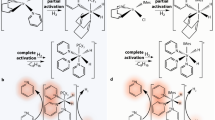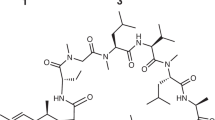Abstract
Nuclear magnetic resonance, conventionally detected in magnetic fields of several tesla, is a powerful analytical tool for the determination of molecular identity, structure and function. With the advent of prepolarization methods and detection schemes using atomic magnetometers or superconducting quantum interference devices, interest in NMR in fields comparable to the Earth’s magnetic field and below (down to zero field) has been revived. Despite the use of superconducting quantum interference devices or atomic magnetometers, low-field NMR typically suffers from low sensitivity compared with conventional high-field NMR. Here we demonstrate direct detection of zero-field NMR signals generated through parahydrogen-induced polarization, enabling high-resolution NMR without the use of any magnets. The sensitivity is sufficient to observe spectra exhibiting 13C–1H scalar nuclear spin–spin couplings (known as J couplings) in compounds with 13C in natural abundance, without the need for signal averaging. The resulting spectra show distinct features that aid chemical fingerprinting.
This is a preview of subscription content, access via your institution
Access options
Subscribe to this journal
Receive 12 print issues and online access
$209.00 per year
only $17.42 per issue
Buy this article
- Purchase on Springer Link
- Instant access to full article PDF
Prices may be subject to local taxes which are calculated during checkout




Similar content being viewed by others
References
Ernst, R. R., Bodenhausen, G. & Wokaun, A. Principles of Nuclear Magnetic Resonance in One and Two Dimensions (Oxford Univ. Press, 1987).
Slichter, C. P. Principles of Magnetic Resonance 3rd edn (Springer, 1990).
Appelt, S., Häsing, F. W., Kühn, H., Perlo, J. & Blümich, B. Mobile high resolution xenon nuclear magnetic resonance spectroscopy in the Earth’s magnetic field. Phys. Rev. Lett. 94, 197601 (2005).
McDermott, R. et al. Liquid-state NMR and scalar couplings in microtesla magnetic fields. Science 295, 2247–2249 (2002).
Ledbetter, M. P. et al. Optical detection of NMR J-spectra at zero magnetic field. J. Magn. Res. 199, 25–29 (2009).
Appelt, S., Kühn, H., Häsing, F. W. & Blümich, B. Chemical analysis by ultrahigh-resolution nuclear magnetic resonance in the Earths magnetic field. Nature Phys. 2, 105–109 (2006).
Budker, D. & Romalis, M. V. Optical magnetometry. Nature Phys. 3, 227–234 (2007).
Kominis, I. K., Kornack, T. W., Allred, J. C. & Romalis, M. V. A sub-femtoTesla multichannel atomic magnetometer. Nature 422, 596–599 (2003).
Greenberg, Y. S. Application of superconducting quantum interference devices to nuclear magnetic resonance. Rev. Mod. Phys. 70, 175–222 (1998).
Ledbetter, M. P. et al. Zero-field remote detection of NMR with a microfabricated atomic magnetometer. Proc. Natl Acad. Sci. USA 105, 2286–2290 (2008).
Savukov, I. M. & Romalis, M. V. NMR detection with an atomic magnetometer. Phys. Rev. Lett. 94, 123001 (2005).
Xu, S. J. et al. Magnetic resonance imaging with an optical atomic magnetometer. Proc. Natl Acad. Sci. USA 103, 12668–12671 (2006).
Savukov, I. M. et al. MRI with an atomic magnetometer suitable for practical imaging applications. J. Magn. Res. 199, 188–191 (2009).
Bowers, C. R. & Weitekamp, D. P. Transformation of symmetrization order to nuclear-spin magnetization by chemical-reaction and nuclear-magnetic-resonance. Phys. Rev. Lett. 57, 2645–2648 (1986).
Natterer, J. & Bargon, J. Parahydrogen induced polarization. Prog. Nucl. Magn. Reson. Spectrosc. 31, 293–315 (1997).
Bowers, C. R. in Encylopedia of Nuclear Magnetic Resonance Vol. 9 (eds Grant, D. M. & Harris, R. K.) 750–770 (2002).
Canet, D. et al. Para-hydrogen enrichment and hyperpolarization. Concepts Magn. Reson. Part A 28A, 321–330 (2006).
Adams, R.W. et al. Reversible interactions with para-hydrogen enhance NMR sensitivity by polarization transfer. Science 323, 1708–1711 (2009).
Atkinson, K. D. et al. Spontaneous transfer of parahydrogen induced spin order to pyridine at low magnetic field. J. Am. Chem. Soc. 131, 13362–13368 (2009).
Chapovsky, P. L. et al. Separation and conversion of nuclear spin isomers of ethylene. Chem. Phys. Lett. 322, 424–428 (2000).
Sun, Z-D., Takagi, K. & Matsushima, F. Separation and conversion of four nuclear spin isomers of ethylene. Science 310, 1938–1941 (2005).
Aime, S., Gobetto, R., Reineri, F. & Canet, D. Polarization transfer from parahydrogen to heteronuclei: The effect of H/D substitution. The case of the AA′X and A2A2′X spin systems. J. Magn. Res. 178, 184–192 (2006).
Carravetta, M., Johannessen, O. G. & Levitt, M. H. Beyond the T1 limit: Singlet nuclear spin states in low magnetic fields. Phys. Rev. Lett. 92, 153001 (2004).
Pileio, G., Carravetta, M. & Levitt, M. H. Extremely low-frequency spectroscopy in low-field nuclear magnetic resonance. Phys. Rev. Lett. 103, 083002 (2009).
Zax, D. B., Bielecki, A., Zilm, K. W. & Pines, A. Heteronuclear zero-field NMR. Chem. Phys. Lett. 106, 550–553 (1984).
Schaefer, T., Chan, W. K., Sebastian, R., Schurko, R. & Hruxka, F. E. Concerning the internal rotational barrier and the experimental and theoretical nJ(13C,13C) and nJ(1H,13C) in ethylbenzene-β13C. Can. J. Chem. 72, 1972–1977 (1994).
Appelt, S. et al. Paths from weak to strong coupling in NMR. Phys. Rev. A 81, 023420 (2010).
Lee, C. J., Suter, D. & Pines, A. Theory of multiple-pulse NMR at low and zero fields. J. Magn. Res. 75, 110–124 (1987).
Dang, H. B., Maloof, A. C. & Romalis, M. V. Ultrahigh sensitivity magnetic field and magnetization measurements with an atomic magnetometer. Appl. Phys. Lett. 97, 151110 (2010).
Koptyug, I. V. et al. Para-hydrogen induced polarization in heterogeneous hydrogenation reactions. J. Am. Chem. Soc. 129, 5580–5586 (2007).
Osborn, J. A., Jardine, F. H., Young, J. F. & Wilkinson, G. The preparation and properties of tris(triphenylphosphine)halogenorhodium(I) and some reactions thereof including catalytic homogeneous hydrogenation of olefins and acetylenes and their derivatives. J. Chem. Soc. A 1711–1732 (1966).
Acknowledgements
Research was supported by the US Department of Energy, Office of Basic Energy Sciences, Division of Materials Sciences and Engineering under Contract no DE-AC02-05CH11231 (T.T., P.G., G.K. and A.P.), by the National Science Foundation under award noCHE-0957655 (D.B. and M.P.L.) and by the National Institute of Standards and Technology (S.K. and J.K.). We acknowledge discussions with M. Levitt and magnetometer-cell fabrication help from S. Schima.
Author information
Authors and Affiliations
Contributions
T.T. designed research, carried out experiments and wrote the paper. P.G. contributed to construction of the experiment. G.K. carried out experiments and theoretical analysis. S.K. and J.K. provided the microfabricated vapour cell. M.P.L. built the experiment, designed research, carried out experiments, simulations and theoretical analysis and wrote the paper. D.B. designed research and wrote the paper. A.P. designed research and wrote the paper.
Corresponding author
Ethics declarations
Competing interests
The authors declare no competing financial interests.
Supplementary information
Supplementary Information
Supplementary Information (PDF 323 kb)
Rights and permissions
About this article
Cite this article
Theis, T., Ganssle, P., Kervern, G. et al. Parahydrogen-enhanced zero-field nuclear magnetic resonance. Nature Phys 7, 571–575 (2011). https://doi.org/10.1038/nphys1986
Received:
Accepted:
Published:
Issue Date:
DOI: https://doi.org/10.1038/nphys1986
This article is cited by
-
Detection of pyridine derivatives by SABRE hyperpolarization at zero field
Communications Chemistry (2023)
-
Possible Applications of Dissolution Dynamic Nuclear Polarization in Conjunction with Zero- to Ultralow-Field Nuclear Magnetic Resonance
Applied Magnetic Resonance (2023)
-
Real-time hydrogen molecular dynamics satisfying the nuclear spin statistics of a quantum rotor
Communications Chemistry (2022)
-
Blueprint for nanoscale NMR
Scientific Reports (2019)
-
Zero-field nuclear magnetic resonance of chemically exchanging systems
Nature Communications (2019)



